When you think of accountants, we know community isn’t the first thing that comes to mind. Let’s be honest, you’re thinking taxes, benefits, profits, losses, valuations and of course the CRA.
But, when you delve into the real meaning of accounting, community is at the root of it.
Being accountable means owning your actions and thinking about how those actions affect the people around you. At SB Partners, we believe that when you make choices that positively impact others, you are accounting for our community. For our 50th anniversary, we decided to shine the spotlight on some of the groups and individuals who have accounted for Burlington during that time.
The terms civic engagement and social responsibility can seem scary. They feel like big commitments, but as you read the stories below, you will realize how simple acts can have a big impact. Take street parties for example, where do they start? By taking the time to get to know your neighbour.
As you read their stories, you will see examples of individuals and organizations who have:
- Demonstrated care, commitment, and accountability for their community.
- Taken the time to be informed about what is happening around them and committed to making a difference.
- Created connections and helped others find a sense of belonging.
Community can mean different things to different people, but the common thread is bringing people together. Community fosters a sense of belonging, provides safe spaces, and facilitates opportunities for change. When communities come together, stories are shared, causes are fought for, and every day feels a little more meaningful.
The following stories are examples of how small acts and big hearts have shaped the Burlington community we call home. These stories show how sharing a hobby or celebration can have a profound impact on someone else’s future. They show how preserving history gives others a chance to learn about where we came from and where we are going. They show how everyone can be a mentor, and how finding ways to support others brings joy. They show that accounting for our community brings positivity and changes the world we live in.
There are so many people that have shaped our community, and these stories are just a few examples. You will see that in many cases you cannot tell one story without mentioning how it connects to another, and that through our individual interests and passions, every one of us can be accountable for our community, in our own way.
The SB Partners Team
Arts and Culture

A vibrant arts and culture scene infuses energy into communities, encourages development and fuels revitalization. Public art projects and community festivals are citizen led and encourage inclusivity and representation. They transform neighborhoods, beautify public spaces, and contribute to the local economy. Civic engagement through the arts helps us to understand and preserve a record of our history, capturing the engagement of community groups in the moment, and encouraging a future, rich in diversity.
Community Theatre
Theatre has a way of bringing people together. It has a way of starting conversations, fueling confidence, and inspiring others. More often than not, community theatres are run by volunteers and funded by grants and ticket sales. From set design and costume making to musical production and fancy footwork, for those involved in the theatre it’s a part of their life they can’t do without.
Burlington is lucky enough to have more than one local theatre group that brings people together, inspires creativity, develops new skills, and encourages civic engagement.
Drury Lane Theatre
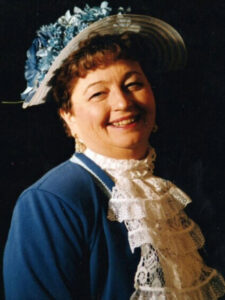 Shiela Paprica and Margaret Campbell were involved with Drury Lane Theatre for decades and Michael Belton is still generating laughter and joy on stage during live musical theatre performances. Their combined efforts showcase how community performance promotes a sense of connection among audiences through shared experiences and emotions, non-verbal communication, social bonding, and collective energy. Between them they have held positions of President, Past President, Secretary, Carpenter, Building Manager, Box Office Guru, and Costume and Props Aficionado – all as volunteers.
Shiela Paprica and Margaret Campbell were involved with Drury Lane Theatre for decades and Michael Belton is still generating laughter and joy on stage during live musical theatre performances. Their combined efforts showcase how community performance promotes a sense of connection among audiences through shared experiences and emotions, non-verbal communication, social bonding, and collective energy. Between them they have held positions of President, Past President, Secretary, Carpenter, Building Manager, Box Office Guru, and Costume and Props Aficionado – all as volunteers.
For every performer, there is a genuine love for all things theatrical, but even more important are the opportunities community theatre offers to individuals, to build confidence, and try something new, while entertaining family, friends, and neighbours.
All the World’s a Stage
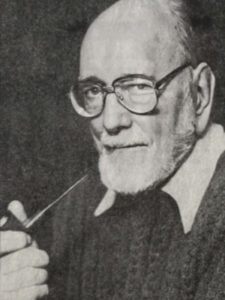 Fredrick Townsend arrived in North America in the late 1950s, from the UK. He settled in the Burlington area in 1969 and joined the Burlington Little Theatre. His work as an actor, director, and community engagement enthusiast increased after retirement. Fred was always around the local theatre, helping to facilitate local groups, providing advice for younger performers, acting, directing, and caring about his community. He would eventually serve as a director of the Burlington Little Theatre and vice-chairman of the Hamilton and Region Arts Council.
Fredrick Townsend arrived in North America in the late 1950s, from the UK. He settled in the Burlington area in 1969 and joined the Burlington Little Theatre. His work as an actor, director, and community engagement enthusiast increased after retirement. Fred was always around the local theatre, helping to facilitate local groups, providing advice for younger performers, acting, directing, and caring about his community. He would eventually serve as a director of the Burlington Little Theatre and vice-chairman of the Hamilton and Region Arts Council.
Fred Townsend left behind a legacy of civic engagement in the performing arts and helped ignite a passion for theatre in countless members of the Burlington community.
Art Through Space and Time
 A guild is an old renaissance word referring to an association of artists or crafts persons. Guilds provide an opportunity to set standards of practice and mentor and share common passion and unique talents. The history of the guilds in Burlington goes back to 1958 with the Wearer’s Guild. By the 1970’s, there were six guilds operating in Burlington including the Burlington Potters’ Guild, Lawton Photographers Guild, Burlington Handweavers & Spinners Guild, the Burlington Guild of Sculptors & Woodcarvers, the Burlington Fine Arts Association, and the Burlington Rug Hooking Guild. The arts have always been a way of bringing people together to create, develop, and perfect their crafts together.
A guild is an old renaissance word referring to an association of artists or crafts persons. Guilds provide an opportunity to set standards of practice and mentor and share common passion and unique talents. The history of the guilds in Burlington goes back to 1958 with the Wearer’s Guild. By the 1970’s, there were six guilds operating in Burlington including the Burlington Potters’ Guild, Lawton Photographers Guild, Burlington Handweavers & Spinners Guild, the Burlington Guild of Sculptors & Woodcarvers, the Burlington Fine Arts Association, and the Burlington Rug Hooking Guild. The arts have always been a way of bringing people together to create, develop, and perfect their crafts together.
At the time, the guilds were meeting wherever they could find space, high schools, city arenas, church basements and artists own homes. The City of Burlington recognized the importance of the guilds but were unable to provide them with the space they needed.
After some consultation, planning sessions, and proposal development an umbrella group of all the guilds was formed in 1972, called Arts Burlington. This group of people committed to raising funds to help pay for what was then called the Burlington Cultural Centre (later changed to the Art Gallery of Burlington – AGB). Their fund-raising efforts raised more than $400,000 and were supplemented by the City and a Wintario grant to secure a place to call home.
The guilds that currently operate at the AGB, provide access to equipment and annual sales opportunities for local artists, educational workshops and events for the public, mentoring for new guild members, and a commitment to the promotion of the arts in Burlington. If you have dropped into the AGB, you may have witnessed artists hard at work in the studios. Their message to you is don’t be shy, step into the studio and ask questions. Welcoming you in is part of their commitment to encouraging their neighbours to explore and experience the arts.
A Score for the Community
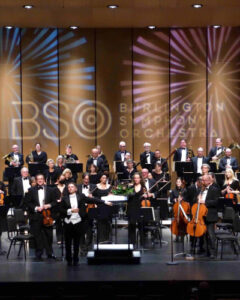
Established in 1974, the Burlington Symphony Orchestra (BSO) serves the Burlington area and the surrounding communities. The Orchestra performed in many locations such as the Royal Botanical Gardens and Spencer Smith Park, before putting down roots at the Burlington Performing Arts Centre in 2011. While their location changed over time, the Burlington Symphony Orchestra has always been a community-based group.
The orchestra has performed at Canada Day celebrations, including one notable concert which involved a host of Canadian songs, performed to coincide with the event’s fireworks. Other events include the orchestra’s annual Christmas concert that includes fan favorites which bring the audience together. When popular songs play, “the whole place sings… You can just hear this roar (of singing).”
In addition to their 6-concert series, community outreach and engagement continue to be a staple for the orchestra. As a volunteer-run community-based organization, the orchestra has benefited from the support of grants, local fundraising, ticket sales, and engagement with local businesses and organizations. Some of these core relationships include the Burlington Chamber of Commerce; local retirement homes; the Burlington Public Library; various churches and functions, including West Planes United Church; and a recent collaboration with Drury Lane Theatre.
Members of the orchestra continue to host information booths and intimate performances that include a chance for members of the public to try out instruments alongside the musicians. As a volunteer organization, they are funded by their own ticket sales and grants. For this reason, outreach and fundraising have been crucial, allowing the orchestra to continue connecting people in the community with music. According to Andrea Battista, a member since 2002, the people in the orchestra “play because they love it, and they want to share. We love it when more people attend events. It’s great for the orchestra, and it’s great for the community.”
Striking a Chord with Gratitude

Andrea Battista has been volunteering in the community for over 40 years, whether it be through the University Women’s Club, fundraising initiatives, organizing concerts, and supporting scholarships for young musicians and female performers in Burlington. As a music teacher, Andrea is part of the Ontario Registered Music Teachers’ Association, an organization who carry out music-related volunteering in the region through festivals, recitals, and scholarships for students.
The Gratitude Project is one of Andrea’s more recent collaborations. Inspired by a poetry anthology on gratitude, Andrea and fellow musicians selected poems about love, death, family, nature, and illness to be paired with songs and musical selections and constructed a concert around these themes. These poems and music were connected based on association, much like connecting a community through shared experiences.
Andrea says, “When you learn music, you’re always going to the next level. It’s hard, and you’re always working. I constantly explain to young performers that the audience is there because they want to be there. They’re there because they like it. They’re there to listen to you and not to criticize you. You can feel the warmth and see their smiles looking back at you.”
Andrea and the BSO plan to continue building relationships with local businesses and promoting awareness about the importance of volunteers to the sociocultural life of Burlington.
Supporting the Arts
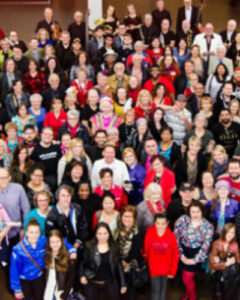 Back in 2013, the City of Burlington created a Cultural Action Plan for the City, including input from local artists. At the time, there was an artist collective who advocated for their community with recommendations such as funding and dedicated space for the arts, public art exhibits, the need to nurture arts and culture in the community, and an external body to pull together local artists and cultural groups.
Back in 2013, the City of Burlington created a Cultural Action Plan for the City, including input from local artists. At the time, there was an artist collective who advocated for their community with recommendations such as funding and dedicated space for the arts, public art exhibits, the need to nurture arts and culture in the community, and an external body to pull together local artists and cultural groups.
Tim Park, current president of the Arts and Culture Council (ACCOB) reflects that almost every recommendation was followed through on, including the external body, which incorporated as the ACCOB, in 2017.
More recently established than other Councils, the ACCOB has had a huge impact on Burlington’s arts and cultural activities. Whether facilitating programming through interactive workshops or partnering with the City on Culture Days, they are always focused on supporting local artists and increasing awareness of the importance of the arts and culture for a vibrant city.
Recently, the ACCOB established a YouTube Channel, which features The Collaborative Experience, a series of workshops entitled “The Painter & The Paintist”, “The Radio Play”, and “The Choreograph”. Each workshop focuses on a different element of artistic expression, expanding on the 2021 project of connecting music with other art forms such as dance, storytelling, and visual art.
This volunteer board of community artists provides a collective voice for the community and continues to impact local decision-making around art and culture ensuring that Burlington is a more vibrant place to live.
The Streets are Alive with the Sound of Music!
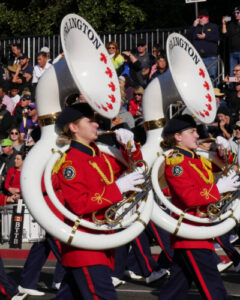
In 1980, Laurie Branch, the then Director of Parks and Recreation for the City of Burlington brought forward an innovative idea to the Burlington City Council. Laurie had a love for bands, in particular, marching bands. His idea was to host a free family-friendly music festival for the City. City Council gave the idea a thumbs up and with only four months to get plans in place he launched what has now been a Burlington tradition for 44 years. It was Laurie’s wife, Marilyn, who named the event the Sound of Music Festival. Marilyn says the event has always been a big deal for their family, describing how Laurie’s vision pulled the whole community together to celebrate local musical talent.
While the festival has seen many changes over the years, the one thing that has never changed is the parade! Marilyn’s voice lights up when she talks about the parade, saying “it will always be our first love”.
Early on, the parade was the centre piece of the festival. Every entry featured a local musical talent and was led by the Burlington Teen Tour Band (est. 1947). People flocked to Brant Street as it came alive with performances and people danced in the street.
Fast forward to 1997, and the Burlington Sound of Music Festival Inc was born as a nonprofit, led by a group of committed community volunteers who plan the event and raise the funds needed to operate the festival, while maintaining the original vision of a free family event.
Hundreds of thousands of people continue to attend the festival every year. The festival has expanded to include a Downtown Streetfest, where families can take a stroll and enjoy the music before heading to Spencer Smith Park for food, fun, and some big-name performers.
Burlington has certainly benefited from Laurie Branch’s recognition of Burlington’s wealth of musical talent and his vision to see us all come together to enjoy it. His vision, along with the efforts of hundreds of volunteers are what make the Sound of Music Festival possible each and every year. The Festival is something that we can all feel proud of and truly enjoy together as a community.
Local Business

Local businesses are critical to building a successful and vibrant city. Not only do they impact the local economy, but many businesses also make intentional offerings to groups and programs. A community depends on, and welcomes, the contributions of business leaders who understand that it is necessary to build up the community that you depend on for success.
Through philanthropic and operational donations these businesses bring communities together and champion the work of local nonprofits. These businesses are a big part of the past, present and future of our community.
A Philanthropic Business Approach
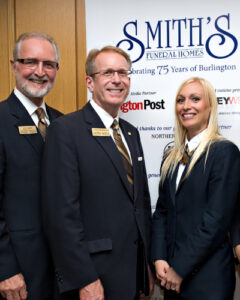 Established in 1938 by Wilbert J. Smith and his sister Jeanette, Smith’s Funeral Home is now led by his son Don. A big part of the organization’s ethos is supporting the community through philanthropy. The Smith Family recognize that the community comes to them in their most vulnerable moments, placing trust in their staff to guide them through difficult times. The way Smith’s strives to honour that trust is to give back to the community.
Established in 1938 by Wilbert J. Smith and his sister Jeanette, Smith’s Funeral Home is now led by his son Don. A big part of the organization’s ethos is supporting the community through philanthropy. The Smith Family recognize that the community comes to them in their most vulnerable moments, placing trust in their staff to guide them through difficult times. The way Smith’s strives to honour that trust is to give back to the community.
Don and his staff take intentional steps to build community relationships so they can have a finger on the pulse of the community, finding ways to make meaningful contributions to services that make a difference in the lives of their neighbours.
Their philanthropic approach trickles down through their teams and is demonstrated by the way the staff engage in the community through work and personal action. Their ethos has been important to attracting staff, but also keeping them. One staff member described herself “as having grown up at Smith’s”, starting as a co-op student, now there 30+ years. Smith’s knows that by supporting the community they are taking care of the friends, families, and neighbours.
If you frequent community events, it’s hard not spot a Smith’s logo, from supporting agencies who work with people with disabilities, and food security organizations, to the arts and local trail systems – Smith’s holds themselves accountable for helping build our community. Smith’s is an example of a local business that is embedded in Burlington, building the fabric of our community.
Raising Money with Ribs

The smell of BBQing ribs. Fingers sticky from the delicious offerings from the best “ribbers,” around. Music filtering through the air. Squeals of delight coming from the carnival rides. The taste of hops in the beer tent. The Burlington Lakeshore Rotary Club’s Ribfest is the place to be on the Labour Day weekend in Burlington. Our local event is so well attended, it is now Canada’s largest Ribfest and has sparked more than 26 other Rotary clubs to host their own events across the country. But, how did it get started?
Back in the early 90’s, the Burlington Lakeshore Rotary Club was recruiting new members. They were looking for individuals who really wanted to contribute to the Burlington community and have some fun while doing it.
To help engage these new members, they needed to identify a great fundraiser that would fuel the Club’s capacity to support the community. Club members Bob Peeling and John Thorpe were the brainchildren behind Ribfest. And it didn’t take much to convince other volunteers to make it a reality in 1996.
RibFest has engaged loyal volunteers, like Paul Kadlick who has never missed the event, now headed into its 28th year! Not only does it engage the Rotarians, it also draws together community members from across the city. In 2023, the event boasted 400 volunteers who contributed a total of 4800 hours during the four-day event. This event also brings thousands of people to Burlington’s downtown, supporting the local tourism and hospitality hot spots.
Even the pandemic didn’t keep Ribfest down. Lakeshore Rotary Club members schemed to create a drive-through event in a mall parking lot so that Burlington residents could have a touch of their favourite ribs on the last long weekend of the summer. This drive through move was mimicked by other communities to keep the ribs and the fundraising going.
The money raised from Ribfest supports dozens of local organizations and funds scholarship opportunities for a high school student going into post-secondary education, as well as an award for an indigenous student at McMaster. This annual event allows local Rotarians to quietly support many programs and initiatives in our community, all the while providing an excellent example of commitment to community and having fun while making one of Burlington’s biggest events happen, year after year.
Burlington Helping Burlington
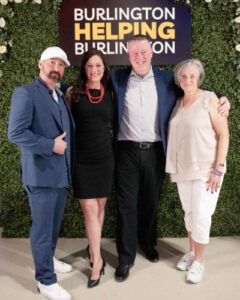
The following story of citizen engagement started on Facebook and has manifested into boots on the ground!
During the pandemic, Burlington’s “CareMongering” Facebook page was created. It became a platform for individuals to share information, provide an outlet to share how they were coping with the situation and offer practical help during the most difficult time many in this generation have known. The online group soon changed its name to Burlington Together and is now over 53,000 people strong. It continues to offer a forum for Burlington and area residents to help each other with a variety of needs, questions, and community support.
Vicki Trottier and Michael Desjardins joined the group’s admin team in the first weeks and continue to be part of the efforts. In September 2023, Mike wondered what would happen if they took some of the Burlington Together positivity off the screen and to the streets of Burlington where the philosophy of local community helping each other could come to life outside of social media in a tangible and meaningful way.
He invited Sean Campbell and Julie Neal to join in, and Burlington Helping Burlington was formed! They initially had a goal to raise food for The Burlington Food Bank and funds for 10 local charities over a 90-day period, but that quickly changed to a decision to stick around permanently which in turn led to setting up a nonprofit organization.
Thanks to many events and so much support from local businesses, Burlington Helping Burlington has raised over $60,000 and collected approximately 13,000 pounds of food so far. Along with donating to local food security organizations and charities, Burlington Helping Burlington gives back to the businesses that offer support by shining a light on those small business owners that could use a boost in a difficult economy. They are all about community helping community!
Each one of the founders of this new non-profit has their own motivation for the countless hours they give back to the community. For some, it is the desire to be a positive example to their children by teaching them about community involvement. For others, it is memories of growing up with very little and embracing the opportunity to be the help their family didn’t have.
This is not the first venture into contributing to, and supporting, the community for this collection of engaged citizens – where they see need in the community, they want to do something to help. What’s obvious is that while they work hard at making Burlington a better place, they have fun doing it with their motto of “Can’t stop, won’t stop!”
A Fund for Today and Tomorrow
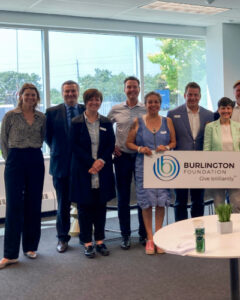
The Burlington Foundation has been leading social progress in our community for 25 years. Founded by Burlington residents, the story of the Foundation is rooted in community. With an initial $100,000 seed donation, the Foundation was established as Burlington’s local community foundation, with the purpose of addressing local needs unique to our city, such as housing, food insecurity, seniors and isolation and the well-being of young people. By engaging residents and businesses to be part of the solutions, through generosity planning and endowment building, the foundation is not just thinking about supporting our community today, they are planning for the future.
Today, the Burlington Foundation brings together leaders from across sectoral divides to start conversations, create change, and steward a $24-million endowment fund governed by its volunteer Board of Directors and Investment Committee.
Since the Foundation’s inception, the City of Burlington has undergone significant transformations and continues to evolve. Our population burgeons with diversity and vibrancy while its physical spaces adapt to embrace this thrilling growth. Yet, beneath the surface, the City confronts challenges once associated only with larger cities. Homelessness, a scarcity of affordable housing, the pervasive issue of food insecurity, mounting mental health pressures, and the strain on our environment due to growth may sometimes overwhelm us. However, the Burlington Foundation stands resolutely as a beacon of support and guidance, assisting community members and organizations in navigating these complex issues and striving for positive outcomes.
Balancing their commitment to provide insights into the needs of the community and meet these needs through grants, while ensuring the long-term growth of the Foundation’s assets remains a top priority. The Foundation provides opportunities for donors and fund holders to network with other donors, as well as businesses in the community, amplifying the impact of their contributions.
Starting or contributing to an existing fund offers so many opportunities to help plan and fund the future of our city. A fund can serve as a platform for imparting important lessons to future generations, including good governance, investment strategy, business principles, and the significance of giving back.
Community Building

Change starts at home. Understanding what our neighbours care about and the issues they are facing provides a starting point for finding a solution. As relationships form and trust grows, we create safe spaces, we feel confident offering helping hands when they are needed, and we feel engaged in our community.
Inherent in community building is the spirit of volunteerism. Volunteering benefits everyone through increased connections and a sense of belonging, improving mental health, and enhancing quality of life. Volunteerism can be an informal act such as helping a neighbour shovel snow, or writing a letter to your local politician about something you feel passionate about, or it can be more formal where you commit to an organization or offer to share your skills for a cause.
A Green Thumbs Up
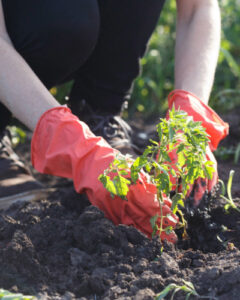
In 1919, a small group of twenty-five residents formed a group that was intent on “beautifying vacant street corners, placing flower beds at entrances to our town and generally assisting our citizens to produce plants, seeds, and trees, as well as instructing them on practical horticulture.”
The founding members of the Burlington Horticultural Society (BHS) include prominent members of the community including Rev. George Tebbs, Paul Fisher, Fred Ghent, and Spencer Smith. They engaged in photography competitions, awards ceremonies, and major projects like the Honour Roll of Trees in the 1980s, which catalogued hundreds of notable imported and native trees in the region. As you explore the city, look for acknowledgements of the Horticultural Society including a pine tree in La Salle Park, a rose garden in Central Park, and a Perennial Bed in front of the Central Park Bandstand.
Today, the Burlington Horticultural Society meets monthly at the Burlington Senior’s Centre on the second Wednesday of every month, and their commitment to their original intent is still true. They raise awareness and add beauty to our neighbourhoods through their annual flower shows, continue to build a collection of horticultural books and audio material, host the elementary school “greening” programs, run horticultural therapy programs, and even support Burlington’s two local museums, Ireland House, and Joseph Brant Wellness House. All possible through the dedicated work of volunteers, and through annual plant sales and raffles.
With a rich history of preserving horticultural traditions, educating future generations, and beautifying our city, the Horticultural Society has been accounting for our community for over 100 years.
Paying it Forward

Sometimes our impact on our community starts before we’re old enough to realize it. When Chase was only four, he was diagnosed with Nephroblastoma, or Wilm Tumor, a cancer that affects children.
The Sandy family were faced with a life altering diagnosis. During what can be a lonely and isolating experience their community surrounded them. Through simple acts like providing meals and offering hugs when there were no words, the family found the strength they needed to stay strong. This community spirit was what motivated Chase and his family to help others, by giving back!
Chase’s Gift began in October 2014, when Chase’s parents and a group of their friends joined forces to find a way of supporting other families in their community. Chase’s Gift celebrated the seventh annual fundraiser in February 2024 with “Toonie” auctions, raffles, and Shawarma catered by a neighbor and owner of Montford’s Restaurant. They have since raised over $250,000 to support others when the need arises.
Chase’s Gift hosts annual fundraisers and has offered a helping hand to hundreds of families over the last 10 years. They have purchased gift cards for newly diagnosed families, provided financial support where needed, and donated to Camp Trillium, creating more opportunities for kids diagnosed with cancer to experience summer camp and have the space to just be kids.
Families with children impacted by cancer go through so much on their path to becoming cancer-free. Every family’s experience is different, but knowing you are not alone can be that beacon of hope you need. By “paying it forward” they have been able to channel the love and support they received towards others. Community initiatives like Chase’s Gift show how compassion and connection are part of accounting for your community and make a huge difference in the lives of the kids who are just trying to get better and the families who are hoping for a brighter future.
Sharing the Highs and the Lows
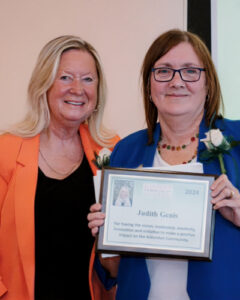
In Burlington’s south-west end neighbourhood, also known as Aldershot, connecting and collaborating is second nature. At the heart of the community are a number of community connectors that bring people, ideas, and organizations together to make things happen over the past twenty years. One of those connectors is Karen Phelps.
In the early 2000’s, Karen was irritated by the way her neighbourhood was treated on garbage days. She noticed that there was more care taken for the houses in the community where homeowners lived, compared to the disregard shown to the inhabitants of Georgan Courts.
Karen made a call to her Ward One City Counsellor, Rick Craven, and that’s how it all started. She and her neighbour, Linda Cupido, decided their neighbourhood needed a voice and a boost, so they started the Warwick Surrey Community Association. Their advocacy work led to the securing of a town house in Georgan Courts, out of which drop-ins, breakfast programs, a food pantry and clothing room, take place alongside programs for children. This hub provided an important place of connection in the community and is now operated as an Our Community Cares site by ROCK.
Karen also convinced the city that there should be a community garden site in their neighbourhood. To this day it is used by residents, many of whom are newcomers living in apartment buildings, who want to show their children how to grow their own food.
In 2003, there were many community minded organizations operating in the Aldershot and Ward One areas. Then Councillor, Rick Craven suggested they all come together to collaborate and have a bigger impact in the community. This is when Partnering Aldershot was born.
Along with the Warwick Surrey Neighbourhood Association, groups like the Lions Club, the school boards, and the Halton Regional Police started meeting regularly to share and network in the name of a greater Aldershot. Karen has played a significant role in keeping this group going along with other active members such as Connie Price who provides leadership for the group’s seniors committee.
Karen’s contributions are vast, but her real pride and joy is the Partnering Aldershot Press. This is now our city’s only hard copy newspaper, which is delivered to 10,000 homes in the Aldershot community, twice a year. Karen speaks about people like Pat Baldry and Sheild Slattery-Ford who were also instrumental in getting the paper going and Judith Genis who ensures that the work continues. The paper has 39 contributing community partners, and engaged local businesses advertise to make it financially possible. The paper is an important source of community information and another example of great things coming out of wonderful collaborations and the community commitment in Aldershot.
Community Dining
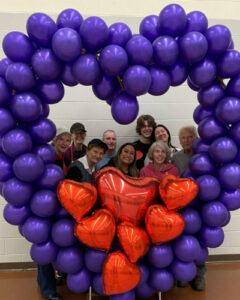
Sometimes all it takes is a conversation to start something special. Back in 2011, Community Development Halton, organized a number of community conversations that brought together dozens of individuals with a passion for community building, north of the QEW.
One of the outcomes from these conversations was a twice-monthly community meal, lovingly called North BurLINKton Dinner Night Out. These gatherings were designed to draw together a variety of people to plan, cook, and serve a meal to dinner guests in a welcoming environment.
The meal is supported by the Glad Tidings Church, Grace United Church, the Burlington Food Bank, and Food for Life. The group collaborates with other services in Burlington such as the Wellington Friday Community, Open Doors, and the Next Door Social Space.
The meals help individuals and families stretch their budgets, but they also offer a chance to get to know one another over a good meal. In the words of one of the lead volunteers, “We want Burlington to feel cozier! We want to know each others’ names. When we see each other in the grocery store we want to be able to stop each other and see how the other is doing.”
The dinner celebrated its 12th birthday in May 2024, and hosted a birthday party complete with cake and ice cream. Great communities always find time for celebration! What better to celebrate than positive connections and good food in community.
Engage in Belonging
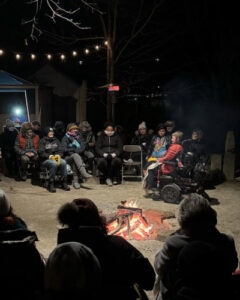
Headed into its 10th year, the Lowville festival was, in part, inspired by co-founder Lorretta Bailey’s deep desire for community. Growing up in the theatre, she saw the arts as a way to gather and engage neighbours and to foster a sense of belonging, something she wanted others to experience.
When Lorretta and her family came from Toronto they settled in Lowville. They were excited by the quality-of-life North Burlington could offer. She soon realized that Lowville could easily be seen as just a few houses on the “little highway” (Guelph Line) that cuts through the countryside to the 401. But Loretta saw so much more. She saw a community that should celebrate their incredible landscapes, showcase local talent, and raise awareness of the local environment.
Lorretta describes the festival as being “touched by many people”, including Bob Missen, Barbara Huget-Anderson, Debra Pickfield, Walt Rickli, Matt Pickfield, Darcy McCallum, Ingrid Hollinger, Eric Trask, John Taylor, Rory Nisan, and Sheri Wainman. With a smile on her face, she talks about the unique gifts every person brings to the events and the relationships and connections that have been developed.
Living up to its tagline, “A Festival for all the arts, for the Artist in all of us.”, Lorretta shares that it’s not just a festival, but an opportunity for “people to share their gifts by way of community”.
Through the years the festival has had some amazing headliners including Leona Boyd, Dan Hill, and Sara Harmer, just to name a few. It boasts events for children to workshop ideas and perform, as well as providing opportunities for local artists to share their gifts with the community.
Although the festival does not have a building, it has a home base at Think Spot and has benefited from the hospitality of the Lowville United Church and St. George’s Anglican Church over the years. The festival is built on Lowville hospitality and generosity. Loretta emphasizes that this event is about people capital, and sharing what you love.
Belonging

As our community develops and grows, small acts of civic engagement are one of the most effective ways of building truly diverse communities, where everyone is included and feelings of belonging flourish.
Whether you are sharing experiences with an intentionally engaged community, or using your voice to speak up for those who can’t, you are making connections, forming bonds, and getting to know your neighbours.
Be Passionate and Get Involved
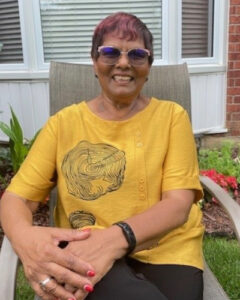
Ancilla Ho-Young was an active member of the community from the day she moved from England to Canada, in 1971. Throughout her career, she took on a variety of roles at Joseph Brant Hospital and became a leading member of the local Nurses Association and a member of the Board of Directors at the provincial level. It was her last role as Charge Nurse of Nina’s Place, that left the biggest impression on her.
Since her retirement in 2016, Ancilla has stayed active in the community, bringing her passion for diversity and inclusion to her advocacy work and expansive volunteer endeavours.
She has led the Burlington Caribbean Connection since 2000, where she has championed their mission to build awareness and promote local understanding and acceptance of Caribbean culture.
She has been a driving force behind introducing local black history month events in Burlington, receiving the John C. Holland award in 2013 for this accomplishment which included engaging community partners. Ancilla is quick to note that one month a year is just the beginning of recognizing the accomplishments of black Canadians.
Ancillas’ focus on diversity is evident through her work as the first chair of the Burlington Inclusivity Advisory Committee and a founding member of the Newcomer Strategy and the Halton Equity and Diversity Board. She is involved with the leadership for organizations such as the Advancement of Women Halton (AWH), Community Development Halton and the North Burlington Baptist Church. Most recently she can be found co-leading One Burlington and local and provincial politics.
Her contributions towards making our community a better place to live have been recognized in the form of awards for Community Service, Citizenship, and the preservation of history.
Ancilla is one of those citizens that has found the issues she is passionate about and acts on them. She believes that when we volunteer, we have an impact and make a difference. Tell Ancilla that you don’t see the importance of voting and she will tell you it’s a privilege and a great first step in showing that you care.
Bound for the Hall of Fame
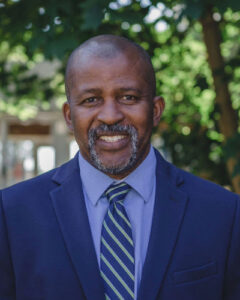
Like most of his friends, Dean Barnes collected hockey cards from an early age. As a Black Canadian, the experience was different than that of some of his counterparts – Dean didn’t see himself in many of those cards.
During the pandemic, Dean decided it was time to finish his 1979-80 O-Pee Chee set. Once completed he decided to make it his focus to collect all the rookie cards for the nearly 100 black players who ever appeared in an NHL game, including the League’s first black player, Willie O’Ree, in 1958.
What started out as love of hockey and a childhood pastime turned Dean into an un-witting historian, who wanted to highlight the “growing impact of players of colour in the sport” and inspire the next generation.
Through his collection, and subsequent podcast “My Hockey Hero”, Dean has not only brought history to life by showcasing diversity in hockey, but he is also helping younger black and biracial players see themselves represented in the sport. During the upcoming season, Dean will be working with the CHL to do monthly podcast interviews of racialized players in the CHL. This will allow fans, particularly young multi-cultural fans, to see themselves represented and promote inclusion.
A simple childhood hobby and a desire to share history has led to an invaluable contribution both to his local community and to the hockey community at large. Dean’s simple act has had such an impact in raising awareness that he, his podcast, and his card collection have had a presence across North America as part of the National Hockey League’s United by Hockey Museum and at the Canadian Hockey League Memorial Cup inside the pop-up Hockey Hall of Fame!
From Isolation to Belonging

Redleaf Cultural Integration (RCI) was founded by Lily Hudson in 2013. Lily was motivated by a personal experience with an individual who felt isolated and unsupported while settling into Canada. As an immigrant herself, Lily had many opportunities to understand how the impact of language barriers, a lack of social interactions, and support in finding a job can make settling in feel like an impossibility.
What started with a Badminton Night to raise awareness around these issues, and bring together likeminded individuals, has developed into an organization that provides opportunities and support for a group of people in the Burlington community who are struggling with the challenges of adapting to a new culture.
RCI’s mission is to build a vibrant Chinese community in Halton. While the organization focuses on the Chinese community, they welcome newcomers from all over the world as they have found there are many similarities and needs between all newcomers.
The organization has a strong focus on creating a sense of belonging and reducing feelings of isolation among newcomers, and achieves this by providing opportunities for social interaction, cultural exchanges, and community engagement.
RCI organizes numerous events and activities, including a choir, fitness classes, traditional Chinese dance classes, yoga sessions, tai chi workshops and a variety of programs specifically designed for seniors and youth, creating a welcoming environment for people of all ages and abilities.
Perhaps best known in the community for their annual Lunar New Year Gala, RCI’s volunteers and program attendees showcase traditional Chinese performances and cultural exhibitions, bringing a familiar celebration to their new community. The event is an engaging celebration and a wonderful example of the impact of others sharing a passion for their culture and being a part of the multicultural tapestry in the city.
Use Your Voice
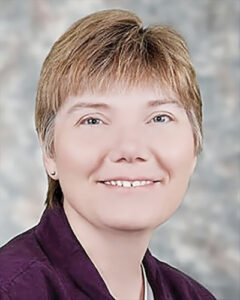
When a child is living with a disability, their parents are often described as their best advocates. Dianna Bower took this role even further and stepped up to be an advocate for all children with disabilities in the Halton District School Board (HDSB).
Dianna first got involved in community through the Halton Downs Syndrome Association, and then represented the Association on a special education committee with the HDSB. At the time, her son was two, and she knew she needed to make sure she did everything she could to facilitate present and future successes and felt that she could be the collective voice for other families as well.
Through her committee work in education, she was integral in organizing the first Parent Involvement Conference. She sat as a volunteer with the Ministry of Education, submitting position statements and working at the policy level so that children with disabilities might be fully included in the education system with the right support, at the right time.
In 2010 Dianna saw a gap in the HDSB and decided to bring her advocacy for disability issues to the next level by running as a Trustee for Wards 1 and 3. Civic engagement in policy issues takes tenacity and a level head. It’s not for everyone, but Dianna took the challenges and the victories in her stride, making sure that the wellbeing of children with disabilities was recognized, valued, and supported across Halton.
Education

There are countless ways that civic engagement finds a practical footing in education. Parent Volunteers and Involvement Committees, educators who run school teams and initiatives, and student-led clubs and leadership groups are all examples of engagement.
Schools are an essential part of our communities and are trusted with educating the next generation. For many young people, an educational setting is where they get their first opportunities to volunteer, join a committee, or stand up for something they believe in. Leaders in educational settings are shaping the civic engagers of the future.
Parent Involvement in Education

When you sit down with Amy Collard, her enthusiasm for diversity and inclusion is hard to miss.
Through her involvement with Joseph Brant Hospital, Big Sisters, and St. Christopher’s Church, as well as her advocate work inside the Halton District School Board, Amy set in motion a path of engagement that led to being an elected HDSB Trustee for Ward 5 in 2010 and Board Chair in 2023.
Amy is a strong voice for special education. In her roles of Vice Chair and Chair of the Special Education Advisory Committee (from 2006 to 2010) she was influential in the Board’s decision to hire more educational assistants and speech/language pathologists to support student success. She speaks highly of the committee’s collaborative nature, with everyone advocating for the different needs of students.
Amy was also involved in the Information Technology for Learners Committee (2007-2009) and was a trailblazer when it came to understanding how integrating technology into the classroom could offer more opportunities for inclusion.
Breaking new ground based on research that says students with engaged parents do better in school, the Parent Involvement Steering Committee was founded in 2007. The Committee developed the first Parent Involvement Conference, which Amy co-chaired, in 2008, a gathering for parents to learn more about the school system and trending topics. This conference continues today, providing an opportunity to spark ideas and inspire parents to be engaged in the school system and their children’s learning.
As a longtime resident of Burlington, a member of the School Board, and an avid volunteer, she has, and continues to create opportunities and programs where all students belong, learn, and thrive.
A Record for the Future
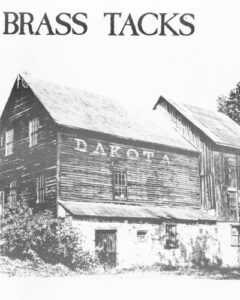
Do you remember a school newspaper, magazine, or some other community publication? From 1978 to 1982, Brass Tacks was a fully student run magazine at Burlington Central High School that featured stories, ideas, research, and interviews.
The publication’s purpose was to share the oral and cultural history of the community. From early topics that included the experiences of the Depression Generation, the history of an old mill, and the inner satisfaction of a craftsman, Brass Tacks set out to represent the true diversity of the community and the experiences of the people – a region that has been described as rural, urban, suburban, industrial, quaint, and modern – all at once!
Brass Tacks garnered more interest than they ever imagined. The publication was a genuine way for the students to engage with the community. They went canoeing along the Desjardins Canal, attended an emotional church service with grandchildren of escaped slaves who made it to Southern Ontario, explored 19th century kilns, tried their hand at water divining, and even visited a 150-year-old tannery! Through these experiences the students made new friends, learned from locals, made memories, and produced an impactful local publication.
Reading issues of the publication is like opening a time capsule – How do you think Burlington has changed since the 70s?
Healing Through Community Awareness
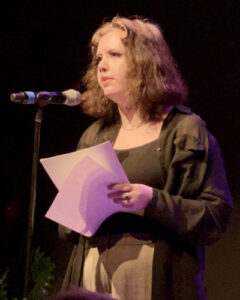
Kai Ruhl is a Burlington resident and the heart and soul behind Supporting Survivors in Schools. As a survivor of gender-based violence, who found that activism helped them heal from their trauma, they decided to bring awareness of gender-based violence into schools, and the community, through education and advocacy.
Kai spent time identifying the gaps and inadequacies in the policies and processes used to deal with gender-based violence, in both schools and the community. Kai’s efforts sparked ongoing conversations within the school board and broader community about the need for schools to have specific policies in place to protect students, and that such policies should specifically name and address sexual assault. Revised versions of the School Boards’ Safe and Accepting Schools policy now make specific reference to sexual assault as a form of inappropriate behavior.
When Kai was in high school, they led a walkout to bring attention to the lack of regard they and others had experienced when allegations of sexual assault were raised at the school.
Kai believes that education is the key to ending gender-based violence and has been working upstream to educate the community through social media, connecting with local organizations, and keeping the topic front and center for the Halton-Wentworth District School Board.
By sharing their own experience with sexual assault, Kai encourages others to find the courage to speak out and speak up. Kai knows that building a community to support survivors of gender-based violence is the first step in raising the collective voice, making sure that progress can be made, and ensuring future allegations are not ignored.
Environment
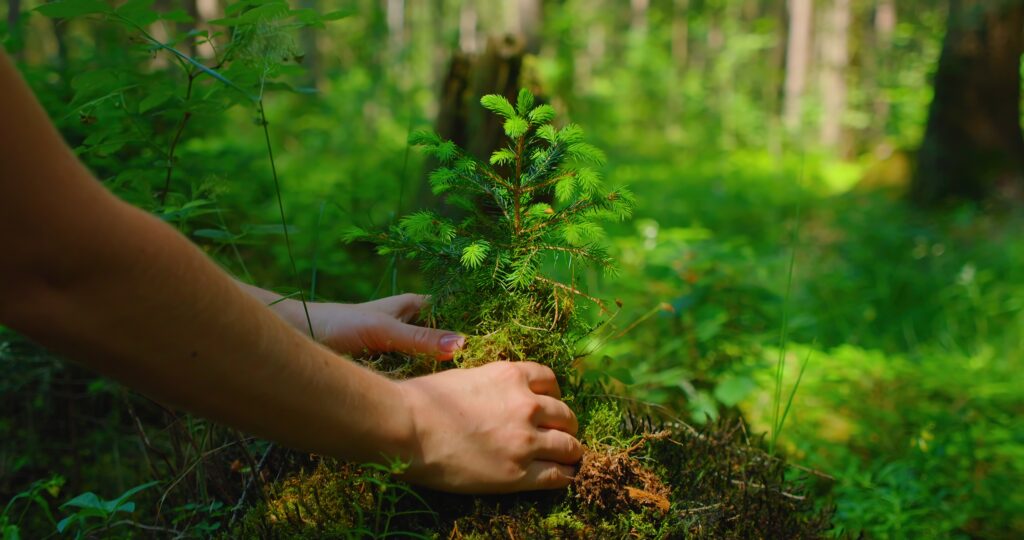
Civic engagement is at the heart of the movements to protect our planet and our local environmental and ecological systems. When individuals raise their voices, educate, and organize others, it results in advocacy for policies and practices that bring the environment, conservation, and sustainable development to the forefront.
Simple acts of civic engagement can include taking time to understand the issues, helping with or organizing a clean-up, letter writing campaigns and being part of the decision-making process through committee work.
Speaking Up for the Environment
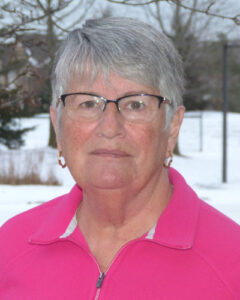
Gloria Reid has been a passionate volunteer in her community for the past 25 years. Gloria did not slow down when she retired from her role as a financial executive in 1998, instead, she took a contract with the International Monetary Fund providing technical assistance to revenue administrations around the world. She “retired one evening and flew to Bangkok the next day”.
During her second career, Gloria visited and lived in various communities, while helping to draft and implement community development plans that focused on the unique goals and needs of each locale. Being able to see so many different societies, how they worked and addressed challenges, sparked an interest to look more closely at her own community. In 2013, Gloria began pursuing her passion for the environment as a volunteer with Burlington Green.
The organization, which “took root” in November 2007, was started when resident Kurt Koster and a handful of fellow citizens formed an advocacy group to speak up for the rights of the local environment. Over the years they have engaged nearly 135,000 clean up volunteers, planted over 74,000 trees and donated nearly 9000 lbs. of produce to the community! From cleaning up and greening Burlington to climate action and influencing public policy, Burlington Green continues to engage the community from its very own eco-hub on Burlington Beach!
We asked Gloria about one of the most impactful memories she had of Burlington Green. She smiled as she recalled the day that Burlington high school students filled the Performing Arts Centre and were involved in a series of talks and workshops provided by the environmental activist and educator, David Suzuki! Watching these students participate in hands on activities, make new connections, and find innovative ways to improve their local environment was inspiring. As Gloria put it, “you can’t beat a good tree planting or a wholesome mustard root pull!”
Getting from A to B
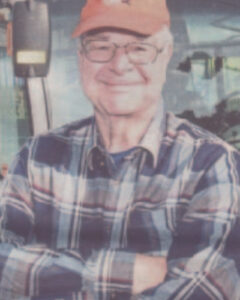 Founded in 2011, in response to drastic budget and service cuts made by Burlington City Council, Burlington for Accessible Sustainable Transit (BFAST) worked to reverse the cutbacks and improve transportation services. In addition to the groups focus on advocacy, BFAST has worked to improve community understanding of the value of local transit as neighborhoods expand. Their community coalition of transit supporters now includes everyone from individuals and businesses to schools and government agencies. BFAST’s approach to advocacy has gained the respect of decision makers resulting in positive service changes for all of us in Burlington.
Founded in 2011, in response to drastic budget and service cuts made by Burlington City Council, Burlington for Accessible Sustainable Transit (BFAST) worked to reverse the cutbacks and improve transportation services. In addition to the groups focus on advocacy, BFAST has worked to improve community understanding of the value of local transit as neighborhoods expand. Their community coalition of transit supporters now includes everyone from individuals and businesses to schools and government agencies. BFAST’s approach to advocacy has gained the respect of decision makers resulting in positive service changes for all of us in Burlington.
To deepen the impact of their advocacy, BFAST hosts Transit User Forums, in partnership with other local community groups each year creating an opportunity for citizen engagement on transit issues. The forum has drawn together hundreds of Burlington residents to voice concerns and ask questions of City staff, transit decision makers, and local council members.
The driving force behind BFAST is a passionate Burlington resident and social activist named Doug Brown. Doug is quick to speak about others who helped get BFAST going, residents such as Walter Mulkewich, David Goodings, and Glenna Cranston, noting that good community advocacy takes a great team of committed citizens. Doug also credits the most recent Burlington Council for its commitment to change in the area of transit, explaining the critical role of responsive local decision-makers to work alongside the community advocates.
Doug is tireless on the issue of transit. He is an active listener, never quick to speak. But when he does speak, people listen. Doug always has a wise, well-researched thought to share that shines light on community issues that he is so passionate about. Doug’s commitment to gathering others around an issue and making space for their voices to be heard is a large part of the secret of BFAST’s success in advocating for better transit for everyone in Burlington.
Protecting the Escarpment
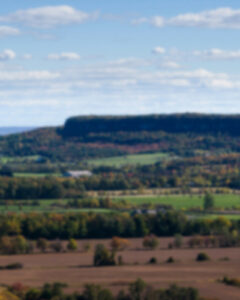
For those who live in Burlington, or who have visited, the Niagara Escarpment is an impressive and unmissable sight on the horizon. The Escarpment is a UNESCO World Biosphere Reserve that includes some of the oldest forest ecosystems and trees in North America and was the result of unequal erosion.
In 2005, when the Nelson Aggregates quarry expansion was proposed on the Mount Nemo plateau, a group of citizens, including Roger Goulet and singer songwriter Sarah Harmer banded together to form PERL (Protecting Escarpment Rural Land), a volunteer nonprofit organization.
The group raised $500,000 to fund the research and advocacy efforts needed to fight the proposed quarry expansion. Over the course of the 8 years that followed, a combination of unwavering advocacy, the careful application of natural heritage science work, supportive Municipalities and Agencies, and a strong legal team, brought their objections to the Ontario Consolidated Hearings Tribunal. In the process of scientific discovery, experts identified important wetlands, and endangered species in the area. These significant features and species were designated for protection by the Ontario Government. After weighing the evidence, the Tribunal unanimously decided to deny the Nelson Aggregates application, in 2012.
Even with that hard work and significant victory, PERL’s work is not over. Nelson Aggregates proposed two new quarries in 2020 that were adjacent to their large scale open-pit quarry off Sideroad #2 on Burlington’s Escarpment.
This time around, PERL is joined by another group of concerned citizens. CORE Burlington (Conserving Our Rural Ecosystems of Burlington) has been actively working to protect the ecological integrity of rural Burlington, including the Jefferson Salamander, an amphibian that was assessed as an endangered species in 2011 and known to inhabit the Niagara Escarpment. Together the two citizen led groups had more boots on the ground and are making great progress to raise another $500,000 to support further research and advocacy.
The Joint Action Review Team (JART) has been able to identify numerous serious problems with Nelson Aggregates application. PERL and CORE Burlington along with the City of Burlington, Halton Region, and the Niagara Escarpment Commission (members of the JART) have all been accepted as “Parties” for the scheduled Ontario Land Tribunal Hearing, in opposition to the application.
PERL and CORE Burlington have continued their advocacy work and expanded the scientific discovery work on the plateau, using hired ecologists, hydrogeologists, air quality expert, and blasting experts. All of the costs have been covered through community fundraising efforts, with no support from governmental funding.
Together, the groups asked our Premier to protect the Mount Nemo plateau from further mining, and to put in place ecologically sustainable mechanisms which will preserve these important biomes and headwaters for future generations. As a result, in May 2024, the City of Burlington Council, and in June 2024, the Region of Halton Council, both passed unanimous resolutions to ask the Provincial Government to deny the Nelson Aggregates appeal and went on to ask for a re-designation of Burlington’s Escarpment plateau to a higher level of protection.
Bring It – Fix It – For Free!
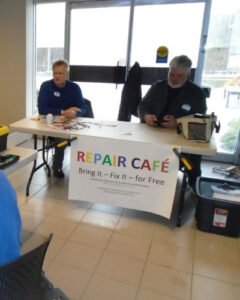
The Burlington Repair Café is one of 3,100 Repair Café’s around the world. At the café, volunteers help residents fix small household items that are broken or damaged, allowing them to remain in use and keeping them out of landfill. Their motto is Bring It – Fix It – For Free!
The Repair Café, which started in 2018, pops up monthly in church halls, community centres, outdoor markets, and malls throughout our community. In addition, the Repair Café hosts “take it apart” events for youth, providing opportunities to learn about the obstacles you might face when repairing items and shining a light on how a culture of repairing can reduce waste.
Their volunteers come from a variety of backgrounds and experiences but mostly are a group that are a bit handy and enjoy using their skills to help repair items for others. Each opportunity draws 25-50 people with items that need to be repaired. Hundreds of small household items have been fixed since the group started, breathing new life into tired objects, and diverting them from landfill.
Making Homes from Waste
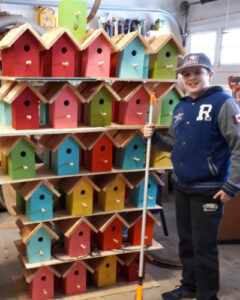
Connor Withers and his dad, Tim, have long shared a passion for recycling and repurposing. Back in the Fall of 2013, when Connor was just 8 years old, the pair collected wood around the neighborhood as a hobby. Together, they would build birdhouses out of the material they found. Tim shared that in addition to being an opportunity to spend time together, the birdhouses taught Connor about the importance of reusing and community values.
As the birdhouses began to pile up, Tim and Connor decided they would sell them outside of Joseph Brant Hospital (where Connor and his siblings were born) and donate the proceeds. Pretty soon, they began connecting with their community, including a group of high school students who took their birdhouses on an exchange program. Their masterpieces made their way to a safari in Tanzania, the Canadian consulate in Hong Kong, and all over Canada and the United States!
When a friend offered to put an ad for Connor’s birdhouses in a local magazine and on the window of a local downtown bank, birdhouse sales soon took off! Connor ended up doing interviews with local news and even TVO kids!
Connor’s birdhouses can still be found at a special garden he and his dad helped build at the Burlington Landfill, where they created birdhouses out of whatever they could find. Their creativity made use of retired wood, glass bottles, clocks, toolboxes, and even a wine bucket! Through their efforts, Connor and Tim were supported by their neighborhood, and many more community members who helped increase their impact.
What began as a father-son recycling project blossomed into a community-wide endeavor to benefit their local hospital. Today, even though Connor has grown up and is now at college, he has maintained a keen interest and passion for reuse, genealogy, history, and community!
According to Tim, “All it takes is a little idea and one person with passion to push it forward. When you start doing a good thing, you just can’t stop.”
It all Started with a Pickle Jar
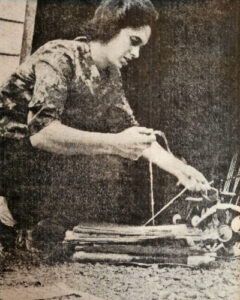
What has lovingly been dubbed as the “Kitchen Epiphany”, was the start of the first sustainable recycling program in Canada. While washing up an old pickle jar and a tin can, Roberta (Robbie) McGregor pondered a new life for these items, that didn’t involve becoming landfill. Being a woman of action, she reached out to local glass, steel and paper producers to find out if they would “take back” the raw materials and give them a new life. With their consent in her back pocket, Robbie reached out to a group of her friends, and in 1970 amid growing public concern and anxiety about the environment, they started a movement and got the whole neighbourhood involved.
News about this innovative group spread fast through local and national media and word-of-mouth. Victims of their own success, Robbie recalls struggling to open her own door one day, because eager neighbours had dropped off so many boxes of materials overnight. Never one to give up, she enlisted the help of a local activist, who helped them form the Citizen’s Committee for Pollution Control (CCPC). They went door to door, collecting materials and storing them in garages until the manufacturers could collect their offering.
This little group of volunteers grew quickly. The City took notice and offered up a house on Brant Street that allowed them to clear out their garages and establish a headquarters. The residential structure was no match for the sheer quantity of material that was being recycled, and they soon moved to a more suitable site at the old municipal works building.
While the CCPC were happy with the impact they were having in the local community, they envisioned bigger things, and believed that a waste management recycling service should be funded and operated by the government. This was the beginning of their advocacy work. Their first win was a pilot project, funded by the province that enabled the town to collect recyclable materials in a concentrated area. This project was a success and in 1973 the project report provided all of the evidence needed to convince the powers that be, that a recycling program was a necessity. In 1977, the Mayor’s Taskforce for Solid Waste Management was formed and included politicians, leaders in local industry, and members of the CCPC.
During their advocacy work, the CCPC also created kits to distribute to local schools that helped a growing generation of individuals who were concerned about the future of the planet to find a way to make a difference and understand their impact.
In 1981, the City brought in a contractor and the work of the CCPC was transitioned over to a city wide curbside recycling program. The CCPC wound down their operations in 1983, having made a bigger impact on the future of recycling than they ever thought possible.
Robbie reignited her efforts in 2012 with Recycling Revisited, an initiative that fed on the success of the CCPC and focused on helping individuals to find peace within themselves by connecting with nature. Robbie doesn’t hesitate to reach out to those who are vulnerable or experiencing periods of negative mental health and helps them to reconnect with the world around them by addressing climate anxiety through action-oriented projects such as tree planting, or fashioning recycled material into products that can be reused, resold, and repurposed. These initiatives help them to see a more positive future for themselves and the planet.
Robbie’s message through time has always been: “Never give up. Figure out what you are most happy doing and make that your life’s work. Believe in yourself, even when others don’t.”
The moral of the story? Never underestimate the significance of a simple pickle jar!
Food Security

As the number of people struggling to access healthy food increases, so has the number of engaged citizens who have stepped up to help others in our community. Whether you are making a donation, volunteering with a local organization, or advocating for policy change, you are making a difference.
Local food supply channels and production is paramount to the future of food security in Burlington. From keeping local farms in business to planting local community gardens, engaged citizens are making sure our food supply remains viable.
Food security in Burlington is tied to immediate acts of kindness and charity and a dedicated group of people who are willing to maintain their advocacy for initiatives that support sustainable agriculture and empower small farmers.
Nourishing the Community
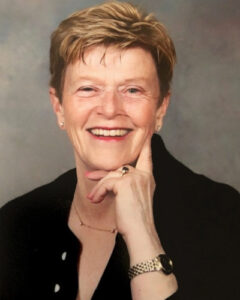
Mary Gowan was born and raised in Burlington. Her family was always involved in the community. In particular, her father set an example for Mary and her siblings. He was a hard-working Dutchman who helped build the first Catholic Church and school in Burlington, setting an early philanthropic example. Mary remembers the annual tradition of sitting around the kitchen table as her father wrote a donation cheque for Covenant House.
Mary raised her children to be involved in the community and embedded the idea of civic engagement with her students during her 38-year teaching career in with the Halton Catholic District School Board. Continuing the family tradition, she worked with her grade 8 students to raise funds for Covenant House, with one student winning the prize of mailing the cheque.
Fast forward to retirement. It did not take Mary long to realize that her retirement would include volunteering. In 2010, Mary decided to give her time to what was then the Partnership West Food Bank (now known as the Burlington Food Bank), which was developed by local churches from the westside of Burlington. Mary became a member of the Board of Directors early on, serving for 8 years (2 as Board Chair).
Based on her experience as a teacher, Mary quickly saw that there was a gap in some of the food bank supplies. Parents really needed school lunch/snack supplies. The solution was the development of the snack bag program, allowing families to come and pick up a bag of school lunch snacks that are desperately needed by families.
When asked about what she has learned during her 14 years of volunteering with the Burlington Food Bank, Mary shares the importance of being in the food bank space without judgement, reminding us that people come to the food bank under many circumstances, needing understanding and support to make ends meet. Mary also notes the importance of finding your own way to get involved and promises that volunteering can be a fun way to spend time in retirement.
Advocacy Through Protection
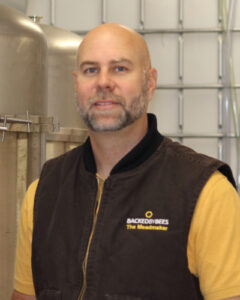
When you think about Burlington, it’s likely that the first thing that comes to mind is images of the downtown area, Burlington Beach, and the many neighbourhoods dotted around the city. However, a significant portion of Burlington’s geography is rural, including our greenbelt, the Niagara Escarpment, and extensive agricultural lands.
In 2018, the City of Burlington adopted what was referred to as the “Current Official Plan”. As a result, the Burlington Agriculture and Rural Affairs committee was formed to advise the City on agricultural and rural issues and raise awareness of this substantial part of Burlington.
Protecting the rural community requires advocacy. The result of land being purchased and held for development is a decreased level of access for others to both enjoy Burlington’s rural community and ensure its vibrancy as productive land. The committee is committed to the process of speaking up for the conservation of the rural community plus ensuring that Burlington continues to have viable agricultural land. That advocacy includes work such as reviewing polices and land use planning documents, providing input on municipal budgets related to rural impact, supporting initiatives to raise awareness on issues like rural infrastructure, transportation, taxation on farm businesses, and educating the residents of urban Burlington on the impact of rural dumping.
The Chair of the committee from 2023, is Vince Sowa. As the local agri-business owner, of Backed by Bees, Vince takes time to be involved because he believes in the critical role that our rural community plays within Burlington. The rural community not only provides a positive economic impact, but it also provides balance to our urban landscape, making Burlington a special place, one of the reasons why Mr. Sowa calls Burlington’s “north”, home.
Vince’s commitment to rural Burlington is an important reminder of the diversity of the City’s geography and the incredible asset our rural community is for all of us in Burlington.
Urban Farmers Unite
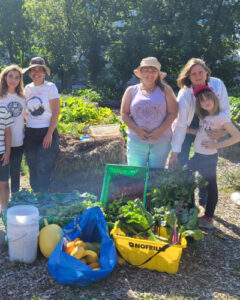
In 2020, during the pandemic, Adria Cehovin decided to get involved “in growing a row”, a term that refers to growing food for others. In this case, fresh produce which could be donated to the local Burlington Food Bank to support others. While formal volunteering was suspended due to COVID regulations, as an independent citizen, this was something she could do to help others.
By the end of 2020, Adria was in conversation with the wider Burlington community about a big idea for growing food in Burlington – she was dreaming of an urban farm. In talking with key supporters – City Councillor Lisa Kerns and the Molinaro Group, dreams moved forward. The Molinaro Group helped by providing temporary access to land; in addition, they cleared the land and provided the expanding community initiative a container for storage and the straw bales they needed to get started. A great variety of food was grown and Burlington’s first urban farm was born!
Beth, another keen gardener who had recently launched Burlington Together, joined the conversation, and helped with a community ask for volunteers and support. The call was answered and brought together dedicated citizens from across the region.
In 2022 this group of voluntary (mainly novice) urban farmers selected the name Bunchberry Connections. When asked about the opportunities created by cultivating a community farm, Adria notes that “it provides a clear opportunity for people to contribute to the common good.” This is what Bunchberry Connections is all about.
Adria describes the farm as having invisible bridges that connect people and organizations. Schools grow seedlings and participate in garden events, local grocery stores donate seedlings, corporate groups volunteer, and partnerships have been developed with the City to invite others in to experience the urban farm at past Open Doors events. Adria is incredibly grateful for the community response and on-going contributions to the farm.
In this two-acre plot of land and with the hard work and dedication of the urban farmers, Bunchberry Connections has grown and donated over 5000 pounds of food to the Burlington Foodbank in their first three growing seasons. When funds allow, they offer free community engagement events to support mental health by connecting people’s well-being with nature. The farm also has a pollinator zone, along Brant St, for the sustainability of their growing efforts.
Adria describes the last few years of volunteering with the Urban Farm as a pivotal part of her life, drawing renewed faith in community from the collective efforts that she continues to experience. Her dream for the future is that more people will become involved in growing food and building community at the farm, for the more hands helping, the more growing possible!
Local Farm Products
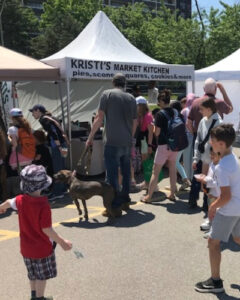
The Burlington Centre Lions Farmers Market has been providing a community gathering space and access point to local food and other products such as flowers, and baked goods for the past 66 years. The market is supported by the Burlington Lions Club, who are celebrating 99 years of service.
The Market started in Burlington Central Park in 1959. In 1968, the Market moved to the Burlington Mall (now Burlington Centre) and has shifted to new locations on those grounds over the years.
The Market has created a space with many loyal vendors, over half participating for at least 10 years, 5 coming for 30 to 50 years and 4 that have been coming for more than 50 years! This represents multiple generations of farm families and local businesses selling their produce in Burlington.
The Market was developed by the Burlington Nelson Lions Club members as a fundraiser. The local producers stall fees go directly into the Burlington Lions Club efforts to support local community needs.
Over its 66-year history, the Market has generated approximately 1.3 million dollars for Burlington & the surrounding community.
What grew from the Burlington Lions Club’s commitment to fundraising for our community’s needs has also created a friendly community space three days a week (May to October), an opportunity to access local food and products, and an enduring opportunity for local farmers and vendors to keep their products in Burlington. Events and opportunities like these are part of what make our community vibrant.
Local Government
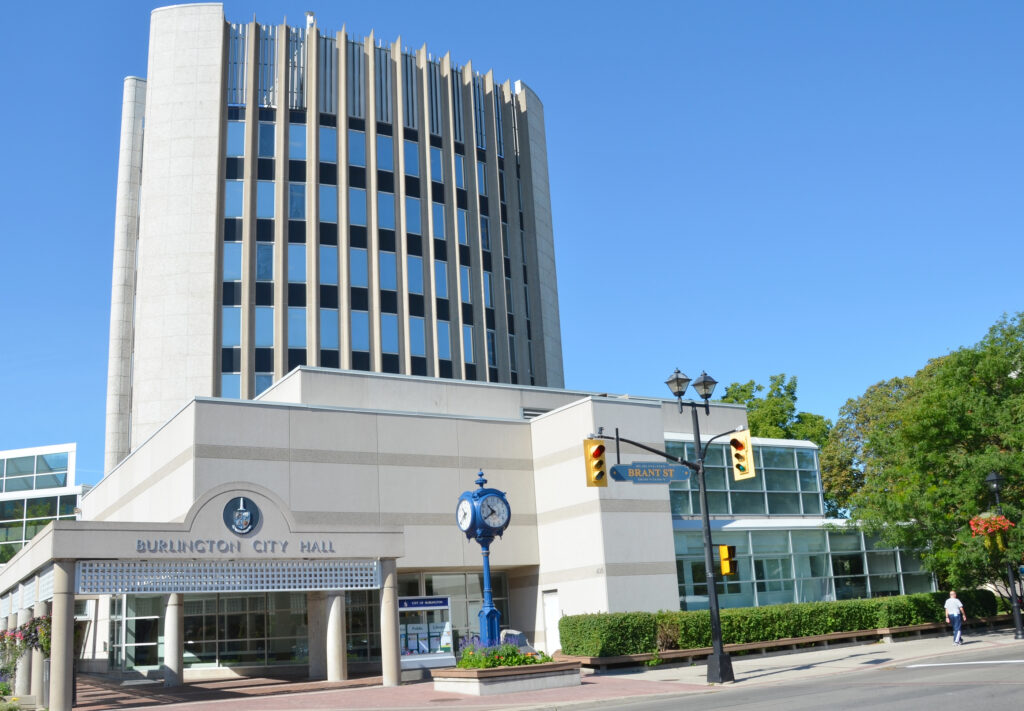
Civic engagement can have an impact on local government. Actively involved citizens can hold government officials accountable for their decisions, ensuring policies and community initiatives are in step with current needs and identified priorities of the community.
Public consultations, community meetings hosted by local counsellors, and local advisory committees, all offer opportunities for government officials to develop a clear understanding of community concerns, preferences, and aspirations. Being a part of local decision-making empowers individuals and community groups to participate in shaping their own futures. The individual act of researching the issues and exercising ones right to vote is a powerful individual step of civic engagement.
Putting Ideas into Action
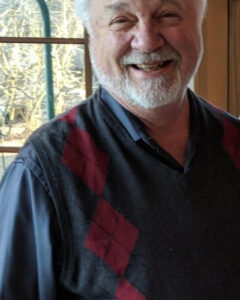
John Taylor is a gentleman who loves to get things started. He loves new ideas and new challenges. He is a natural organizer and the guy at the meeting with all the facts.
Although his education and his work took him to the world of science, John always knew he wanted to be involved in politics. He was an organizer at work and in his community.
John settled in Burlington with his family, then became involved with his condo board. He started paying attention to local Burlington Council decisions and assessing how they would impact his neighbourhood. He ended up delegating on a new tax distribution policy that he felt did a disservice to Burlington residents living north of the QEW. Realizing that through politics he could make a difference in his community, he started reading up and paying close attention to what was happening at the council.
In 1988, he made the decision to run for a seat in Ward 3 and won. During his 30 years of service, John was a strong champion of Burlington’s rural community, always making sure those residents north of Dundas were heard.
Living in Burlington, transportation was an important issue for John. He advocated for, and brought to fruition, the Split Pass for Halton residents, making transit more affordable for many residents. While he saw the importance of making transportation simpler, he was also concerned about how changes to roadways would impact on his community. John worked hard to have the proposed cloverleaf for a Highway 407 entry/exit at Upper Middle Road removed as well as championing the removal of a provincial plan to run the proposed Mid Peninsula Highway through the Escarpment in Burlington.
In recognition of his many years serving on city council and his advocacy on behalf of rural residents and more affordable transportation in Burlington, John was an honoured recipient of the Ministry of Municipal Affairs and Housing’s Long Standing Service Award during a meeting of Burlington City Council in December 2014. It was John’s ninth term serving Brant Hills, Mountainside, Kilbride, and the rural communities west of Walker’s Line.
John may have retired from politics, but he is still a very active and engaged citizen. He still follows local decision making and shows up at town hall meetings. He was last spotted at a neighbourhood meeting helping to plan a local festival with his likeminded community organizers.
From Teen Tour Band to Local Politics

Raised in Burlington, Andréa has been involved in the community since the year 2000, when she combined her passion for music and photography, and served as the voluntary webmaster and photographer for Burlington’s Sound of Music Festival. Andréa started her music career as an active member of Burlington’s iconic Teen Tour Band, where she played the oboe!
Fast forward to her children being in school. Andréa attended a boundary review meeting where she noticed changes that concerned her. The review meant that many neighbourhood children were going to have to leave their local school to go to three different schools because there was a City of Burlington policy in place that didn’t allow portables. This rule resulted in a hard cap on school enrollment numbers. Andréa spearheaded the portable issue with the City of Burlington, taking it through the delegation process and pushed the school board to do the same to address the issue from the enrollment cap side. Her voice was heard, and the school installed four portables, keeping most of the local children in their neighbourhood schools.
This was her first foray into the process of policy review, and Andréa felt like it was a positive way to be involved. So, when Jennifer Hlusko stepped away from the school board to run for City Council, and she suggested Andréa run for the role of Trustee. Andréa naturally said yes. In 2014, Andréa ran for, and won, a seat as the Halton District School Board as Trustee for Wards 3 and 6 in Burlington. In 2018, she was elected to be Chair of the Board by her trustee colleagues and continued this tenure for four annual terms. Through this role she leaned into relationship building with local mayors, the Regional Chair, councillors, MPPs, and MPs.
The community needed schools, and ironically, Trustees do not have direct access to the decision makers in the Ministry of Education. Andréa used the relationships she was building and realized that our local politicians had the access she needed. Andréa made sure that these individuals were able to carry the voice of the school board up the ranks, ensuring that all Halton children had the facilities and support that they needed.
Andréa believes that the successes she has experienced in her career highlight the importance of collaboration and relationship building to bring the right messages to the attention of decision-makers. Andréa believes that student achievement AND well-being are two essential elements for student success, and this is worth advocating for.
Andréa stepped away from the School Board in 2022 to run for Halton Regional Chair. Although she did not win, she is thankful for the experience. As she worked to connect with individuals over the 1000 square kilometers of Halton, she was reminded about what matters to her neighbours and what an amazing community she lives in. Currently Andrea serves our community as a volunteer, and as a member of Burlington’s Integrated Transportation Advisory Committee.
A Champion of Public Service
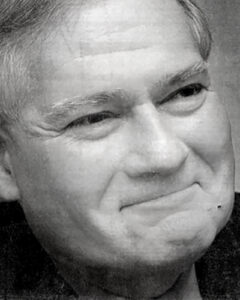
Walter Mulkewich (1940-2022) was involved with his community for much of his life. He was a history and geography teacher at Oakville Trafalgar High School, ran for the NDP, and then for Burlington City Council. Walter was a forward thinker, and, when he won Ward 1 in 1976, he was known for being able to change his colleagues’ minds on key issues, namely on improving awareness and access to mental health treatment and support.
Mulkewich was elected Mayor of Burlington, in 1991 and again in 1994. His bid for a third term was thwarted by his diagnosis of leukemia. Walter, a true leader, shared his initial diagnosis, and over the years that followed a second diagnosis and very personal details of the loss of his wife. By sharing, he raised awareness around the societal perceptions of dealing with death, dying, and mental health. Through his own circumstances, he was able to increase the level of community responsiveness to these important issues.
It wasn’t in Walter’s nature to slow down. Through his volunteer career, Mulkewich held positions with many organizations including the Burlington Performing Arts. In 2001, he joined the Hamilton Port Authority and was heavily involved in cleaning up the Hamilton Harbour. In 2009, Walter, joined John Boich, to lead the Shape Burlington initiative which was widely regarded as the gold standard of civic engagement in Burlington. In 2011, Walter was fundamental to garnering support from the Burlington Council to increase funding for the Randle Reef cleanup.
Walter was a natural leader and put his heart and mind into every project he got involved with, earning the respect of the Burlington community.
A Brisk Wind of Change
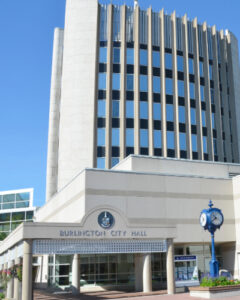
In fall 2009, retired Halton School Board Superintendent, John Boich, and other concerned citizens, felt there was a need – and an opportunity – to lead an initiative that gave the residents of Burlington a closer connection to the decision-making process at City Hall. This came in the form of the Mayor’s Citizen Advisory Committee on Civic Engagement, or as it was more popularly known, Shape Burlington. This committee was formed by the standing mayor, Cam Jackson.
Boich became the committee’s co-chairperson, along with former mayor Walter Mulkewich. Together, they oversaw the work of 30 other residents who formed part of the committee. The pair wanted the committee to ensure simpler and more effective two-way communication between the citizens and the City of Burlington. Shape Burlington become a forum, where individual and collective voices were heard.
Several well-known Burlington residents joined the committee, including businesswoman Blair Lancaster, Hamilton Spec freelance columnists Lorraine Sommerfeld and Hussein Hamdani, former alderman Leslie Bullock, and community activist Doug Brown. Their first action performed by Shape Burlington was to establish a survey where residents could share their thoughts about the state of civic engagement and opportunities, weighing in on key local issues.
The result of the survey, was a 78-page report, entitled Shape Burlington, that shared eight recommendations. One key recommendation was an Engagement Charter, a City Hall Rulebook outlining procedures for citizens to influence local policies. Others included giving citizens more say in preparing Burlington’s strategic plan, encouraging better quality media coverage, and encouraging City Hall to conduct outreach to minorities and youth.
Shape Burlington was initiated during a time of great change in the community. The population was increasing, and Burlington was welcoming a diversity of cultures. Shape Burlington was a welcome opportunity for everyone to contribute to the community’s democratic processes and empowered residents to engage with local government. While the process was messy and turbulent at times, the perseverance of engaged citizens existed to facilitate a more connected decision-making process between the council and residents, and to help encourage trust and transparency in local government.
Burlington’s Longest Serving Mayor
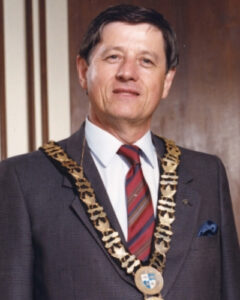
Roly Bird (1931-2004) was Burlington’s longest serving mayor and was in office from 1979 to 1991. He was so popular that worthy opponent, Walter Mulkewich, vowed he would not run for mayor as long as Bird was in office – True to his word, Mulkewich did not seek the job until Bird retired!
While in office, Bird was the number one advocate for his community. He ensured that the City had the final say on the design and planning of incoming developments to ensure they met the community’s needs, and not just the needs of developers. He was integral to the establishment of social and economic connections with the city of Itabashi, Japan. He even brought the Burlington Teen Tour Band along for a delegated trip where they got to perform at the Hula Bowl in Honolulu enroute to Japan and made a special appearance at Pearl Harbour to play O’ Canada.
In the years after his retirement from politics, Roly Bird was not idle. He established the mayoral archives at the Burlington Public Library, where you will find historical photographs, memorabilia, and other political records that tell this meaningful part of Burlington’s local history.
Advocating for Barrier Free Communities
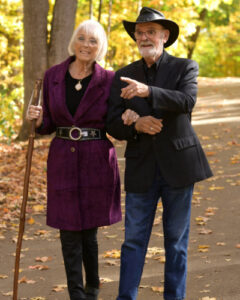
The story of Anne and Dave Marsden began in the North of England when their lives collided at the Billingham Technical College dance in 1964. The pair married two years later and with a sense of adventure they planned a two-year excursion to Australia, but life had a different plan. They changed course to spend two years in Canada, and never left.
Anne and Dave settled in Burlington in 1972, where their advocacy work began. Anne took a position at the newly constructed McMaster University Medical Centre (MUMC) doing administrative work, where she learned valuable skills in data appraisal and legislative compliance – tools that would later inform her advocacy work with Dave, who also worked in legislative compliance for the federal government.
One of the highlights of Anne and Dave’s advocacy work was in food security. In 1991, they coordinated with local food banks to create a “challenge” for the community to fill the food banks for Easter. A family project that included all three of their boys, Dale, Adam, and Jay. Through newspaper articles, word of mouth, and more than a few themed buttons, they raised over $1000 to help people access food they wouldn’t normally find at food banks.
In 1993, Anne served as the Chair of the Burlington Committee for the Physically Disabled, with a major project focusing on the issue of patients being housed in hospital corridors.
From there, Anne and Dave began to apply their skills in legislative compliance to support families seeking to be reunited with their children. The couple supported children and families from diverse communities throughout Ontario, including families who homeschooled, refugees, and those living with disabilities. Anne described the role they played in reuniting families as a calling to address injustice in their community.
Their advocacy continued when Anne’s mother was in hospital. Their new purpose was to promote transparency, accountability, and engagement within health care services for the benefit of the most vulnerable patients. They brought forward concerns, such as accessibility, to City Hall. Raising issues that many people wouldn’t even notice – like removing the step leading to the Burlington Council table or the snow removal that would get piled into accessible parking spots each winter.
The 90’s also saw them take their advocacy and accountability efforts up a notch by placing Anne’s name on the ballot for Burlington/Halton School Trustee, Burlington MP, Burlington MPP, Burlington Mayor, and Halton Chair.
Anne came in second place in the Mayoral race of 2014. An article in the Burlington Gazette claimed that “Ms. Marsden is a tireless advocate for the disabled and a true champion for the democratic rights of voters. She made a very strong and necessary case for ensuring the public’s right to have input into the decisions made.”
From advocating for accessibility and democratic participation in decision-making, to working towards greater transparency, justice, and accountability within our systems and institutions, Anne and Dave Marsden are glowing examples of what it means to account for one’s community. Today, the couple enjoy spending time at their favorite park, or along the shores of Lake Ontario that reminds them of the English coastline they once enjoyed, or working on a memoir detailing their own accounts of how they have accounted for their community!
Preserving Local History
Civic engagement plays a big part in preserving our local history. From historical interpretation and education to archiving and documenting the past, there are many individuals and organizations at work across Burlington. From finding ways to preserve historic buildings and artifacts to telling the stories of our ancestors and advocating for historical designations, the volunteer hours are high.
When citizens are involved in this work, they foster community ownership and strengthen the identities of our communities. Active citizens in this area remind us of where we’ve been, help us learn lessons from the past and ensure the narratives are safeguarded and celebrated for generations to come.
Friends of Freeman Station
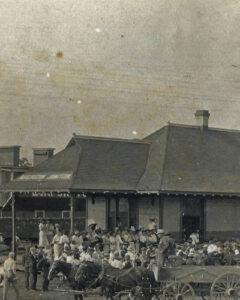
Transportation has long been at the heart of connecting communities. Freeman Station (officially Burlington Junction) was established as a hub to connect the developing areas around Burlington with major cities such as Toronto, Chicago, and New York. Over the years, many of our ancestors rode that railway for business or leisure, and even soldiers to start their expeditions to the front lines.
As the needs of society change, so do the infrastructures needed to support them. Unfortunately, in 1988, as other modes of transport became more popular, a new larger station was built – better suited to deal with demand. The need for a smaller station was no longer there and Freeman Station was decommissioned.
When professional engineers deemed that the building could not be saved, the fate of Freeman Station seemed inevitable. However, members of the community banded together to form the Friends of Freeman Station, a not-for-profit group who advocated to preserve local history. Together they saved, rebuilt, and reinvented Freeman Station, relying solely on the skills of volunteers to bring history back to life.
One of these volunteers, Alan Harrington, points out how volunteers worked together to restore the station to its original glory and create a space where people could come and learn about local history and find themselves in it. The thought that went into the restoration was intentional, ensuring the site would reflect that the station as a place that moved people, products, and information.
The restoration includes a mural that stands on an outfacing wall and is based on an old photograph detailing some of the people and produce that put Burlington on the map, as well as bringing an original boxcar and caboose back to their intended look and feel. The Station itself contains telegraph machines, 19th century telephones and furniture, and the original hardwood flooring! One notable marker is the unique oval window at the side of the building, which is featured in the logo of Friends of Freeman Station.
This group of community minded individuals didn’t just save the four walls that were set to be knocked down, they discovered and saved stories of love, sadness, adventure, and community for the next generation to discover.
Giving Our Past a Place in the Present
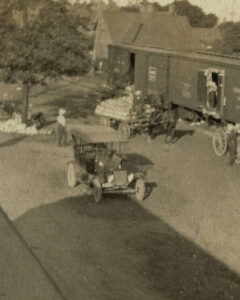 In Burlington, the people and the stories we tell are part of what connects us as a community, past and present. Since 1899 the Burlington Historical Society (BHS) has been serving the community by making history accessible and relevant for today while cultivating interest in local history for future generations. Between the central repository for Burlington’s history at the Archives, guest speaker presentations, outreach efforts in the community, and a monthly newsletter (the Gazette), the BHS continues to engage residents in big ways.
In Burlington, the people and the stories we tell are part of what connects us as a community, past and present. Since 1899 the Burlington Historical Society (BHS) has been serving the community by making history accessible and relevant for today while cultivating interest in local history for future generations. Between the central repository for Burlington’s history at the Archives, guest speaker presentations, outreach efforts in the community, and a monthly newsletter (the Gazette), the BHS continues to engage residents in big ways.
Alan Harrington is one such community member who has fostered a deep passion for local Burlington history and civic engagement. As a member of the Historical Society since 2005, Alan helps facilitate a great many projects and initiatives, including walking history tours of La Salle Park and Freeman Station, as well as clean-up and restoration initiatives such as the Cemetery Care Project.
Alan is currently focused on the upcoming clean-up that the BHS is planning at the 176-year-old United Empire Loyalist heritage cemetery, which began in 1848 by ten local families. Alan, and about 10 other volunteers will help clean up and preserve this important piece of local history and honor the final resting place for many of the region’s early settlers and loyalists.
Like the work of the BHS and historical sites like the UEL Cemetery, Alan and his family have deep roots in the region. Alan himself has been in Burlington since 2003, and his family can trace their local heritage in the region all the way back to 1820 when his ancestors immigrated from the United States and Europe.
Alan appreciated the interconnectivity between people and stories – when we learn a little bit about an historical site, document, or story, we begin to find connections among them. Collecting stories and sharing them with a wider audience is a big way to create these connections in the community. According to Alan, “if we don’t tell our story, nobody will. It’s our story, and we have to honor the work our ancestors did and all the hardships they went through to get us to where we are now.”
A Local “Restorian”
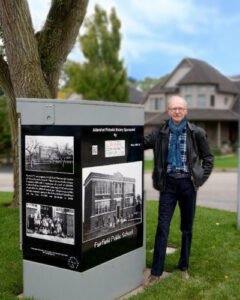
What began as an exploration of old photos with a friend’s father, Tom Oliver (a news photographer in the early 1950’s), would grow into a city-wide social history project. David always had a strong interest in restoring old images and found a way to create narratives out of historical photos for folks to enjoy and learn about their community.
It all began about 12 years ago, with a project to display a picture on a Traffic signal control box. David Craig found a photo of a young Tom Oliver selling sugar-salmon cantaloupes at a fruit stand at Plains Road and King Road in Aldershot in 1938. David shared (in a Burlington History Minute video) how Burlington was long considered the “garden of Canada”. The fruits and vegetables grown here were “shipped all over the world, even to the tables of royalty in Europe.” It is hard to look at the image of Tom at his fruit stand and not wonder, where might Tom’s cantaloupes have ended up?
The historical images that David restored can be found on traffic signal control boxes along Plains Road. Other works include a sign in commemoration of the Brant Inn at Spencer Smith Park and images from the early Urban Transit System that linked Hamilton to Oakville and everything in between, at Elgin Square on Brant Street.
Part of what makes David’s story so special is that it represents a personal passion for restoration and the story of the community itself. David also created a series of 20 large posters for the Burlington Historical Society and has helped make local history interactive and accessible – an exercise in preservation, remembrance, and community.
Sport

Sport is a powerful tool that brings people together and builds social connections across diverse groups of participants. Through the civic engagement of community leaders and volunteers, grass root and organized sport provide opportunities that develop skills, build character, improve health, and provide opportunities to work together.
Sport can also be seen as a vehicle for change. Through passionate individuals and acts of advocacy, the playing field has changed to create a more inclusive environment that champions equality and encourages everyone in the community to enjoy those benefits.
Inclusivity in Sport
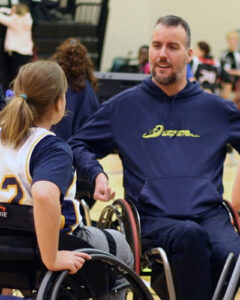
Chris Chandler and his family moved from Wales to Canada when he was 11 years old. Chris is quick to let you know that he was born with a fractured neck, resulting in him being a quadriplegic. He is just as quick to share his passion for sport. This is a passion that has led to the development of a strong wheelchair basketball program that engages youth in Burlington and the Golden Horseshoe.
When he arrived in Burlington, he joined the Burlington Disabled Sport Association (BDSA) (renamed the Golden Horseshoe Disabled Sport Association) and tried baseball, track and field, swimming, and sledge hockey. Chris realized he loved sports and being part of a team, but he wasn’t a fan of the cold! Through the BDSA, Chris got involved in the Vipers Wheelchair Basketball Program. Instantly the shy young man Chris was in his day-to-day life, came out of his shell and ended up in the role of team captain. His wheelchair basketball career flourished, and he even competed competitively with the Vipers.
In 1997, the Vipers needed a volunteer coach. Chris was 20 and had no coaching experience, but decided it was his turn to step up. He took his role seriously, taking every opportunity to learn how to support the team and reached out to other coaches for mentoring. His coaching skills lead him to international success with a national team who won the world championship in Japan.
Ten years later, Chris decided to return to his roots with the Vipers. Working with a whole host of volunteers, he developed a more inclusive wheelchair basketball program that gave everyone equal access and support. This program, supported by more than 100 volunteers, means that children and youth across the Golden Horseshoe can play for fun or competitively.
Chris and his volunteers take passion to the next level, ensuring young people with disabilities are not treated as “different”, but as the athletes that they are.
Volunteers for the Win!

Committed to developing amateur youth hockey, The Burlington Lions Optimist Minor Hockey Association (BLOHMA) was formed in 1951 and remains one of the longest serving youth organizations in the City. Their recreation program is open to everyone, regardless of experience, and focuses not just on technical skills, but on developing the character of its participants and fostering true sportsmanship.
In the early years, the hockey association was formed and run by members of the Burlington Central Lions Club and the Optimist Club of Burlington. With over 1800 players between 4 and 18 years of age that register annually, volunteers are the beating heart of the organization. With over 500 volunteer roles, community members support BLOMHA as coaches, trainers, and team managers for over 90 teams.
While parents often step into these roles, there have been many who have stayed committed to the association well after their children move on. Until 2015, the organization was led solely by volunteers, including Rick Dawson, who served as Board President and volunteer, until being named as the first Executive Director. Rick notes that there are other individuals who have poured hours into the hockey association such as volunteers Larry Fennel, Ted Callis, and Jim Hart. Among these three Burlington residents, there are close to 75 years of volunteer contributions!
When asked why he got involved with BLOHMA in the first place, Rick shared that as a member of the then Burlington Police Force in 1969 they were encouraged to get involved in the community. Rick chose to invest his time into youth hockey to help uphold BLOHMA’s goals of developing each player to their full potential. He is thankful he was encouraged to get involved so many years ago, and highlights that BLOHMA, like other nonprofits, needs more volunteers than they have. Could you be their next volunteer?
Somersaulting Their Way Forward
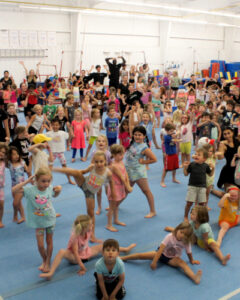
What started as an after-school gymnastics club, for girls, at John T. Tuck Public School, 55 years ago, now trains over 3000 gymnasts at both recreational and competitive levels.
In the early days, Noel Thomas, whose daughter was part of the after-school program, volunteered to set up and tear down all the gymnastics equipment so that practices could happen. Knowing that this wasn’t sustainable Noel and a teacher, Karen Pipes, approached the coach Bob Wiggins, about finding a way to make the club a permanent fixture. With a group of fellow parents, they proposed a partnership to the City of Burlington where the City would provide the property and money up front, and the club would pay the loan back over time. The City said they would consider the proposal, but the club would need to prove that the demand was great enough.
This determined group of volunteers raised the funds to rent an industrial space on the North Service Road and converted it into a full-time gymnastics club, with all the equipment they needed to be taken seriously. Over the next three years, the club would grow to 1000 gymnasts.
When they approached the City again, there was no doubt that they had proved there was demand. With the support they needed, including a Sport Ontario grant, a permanent facility was built in 1980 that included an artistic gymnastics gym, a separate rhythmic gymnastics gym, a viewing lounge, change rooms, and office space. The loan was repaid within 10 years.
As the club grew, so did the need for a board of directors, of which Noel became the first President. In 1979, Noel and Karen invited Mary Nichol who brought with her a love for gymnastics and international judging experience.
Gymnastics as a sport continued to grow. The Maple facility could not accommodate the demand. The BGC rented space north of the QEW on Mainway for 15 years, and is this year moving again onto the North Service Rd.
The story of the Burlington Gymnastics Club is one of determination and commitment to sport by a dedicated group of volunteers, coaches, and staff.
All Round Advocate for Sports
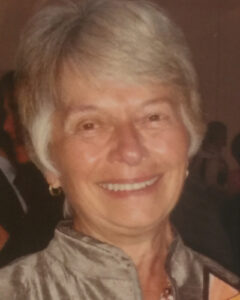
Mary Nichol’s contribution to sport in Burlington didn’t stop with Gymnastics. She is a shining example of what can be achieved when you bring your passion to the community.
In addition to being an award-winning teacher, international gymnastics judge and BGC board member, Mary developed the Annual Burlington Spring Cup Invitational Gymnastics Competition in 1988. This event became the largest invitational Artistic gymnastic competition in Canada with over 2000 athletes competing in all levels of difficulty, and now includes both Artistic and Rhythmic Gymnastics. It continues today over 2 weekends.
Outside of Gymnastics, Mary helped to conceive of, and serve on, the original board of the Burlington Sport Alliance. She served as chair from 2003- 2017. In 2004 the first Burlington Sport Recognition and Awards Dinner was created to honour athletes, coaches, officials, and volunteer builders. Mary chaired the dinner for three years and still serves on the organizing committee. During this period of BSA leadership, the Burlington Sports Hall of Fame started as a subcommittee of the BSA with Bryce Leggatt acting as its Chair. It is now a strong independent sport organization also honouring sport success and volunteerism from Burlington’s past.
In 2015, through her role with the Burlington Sport Alliance, Mary, along with Paul Tomlinson, were a driving force behind a community initiative called Have a Heart for Burlington. The group’s objective was to increase access to sport and recreation for all children and youth in Burlington. The group supported grass roots sports initiatives, helped the BSA and City Parks and Recreation staff host Sports Day in Burlington, and offered free access to sport for children and youth for several years.
Mary still serves on the Board of Directors for the Burlington Gymnastics Club and the BSA Sport Recognition and Awards Event,
Mary truly believes in the power of sport for youth development and the building of strong communities. Her contribution to sport in Burlington has been a clear demonstration of commitment and passion.



